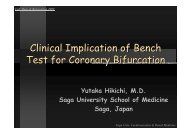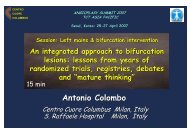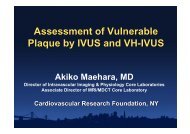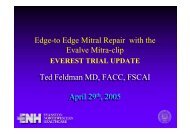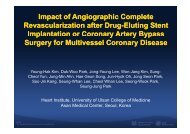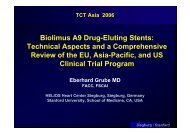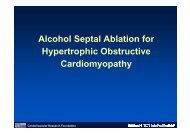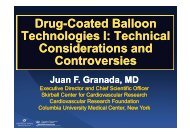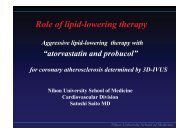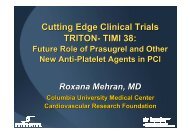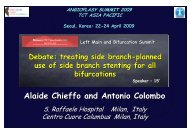Stenting in coarctation of the aorta- Shall all ... - summitMD.com
Stenting in coarctation of the aorta- Shall all ... - summitMD.com
Stenting in coarctation of the aorta- Shall all ... - summitMD.com
You also want an ePaper? Increase the reach of your titles
YUMPU automatically turns print PDFs into web optimized ePapers that Google loves.
<strong>Stent<strong>in</strong>g</strong> <strong>in</strong> <strong>coarctation</strong> <strong>of</strong> <strong>the</strong> <strong>aorta</strong>- <strong>Sh<strong>all</strong></strong><br />
<strong>all</strong> adolescent & adults receive covered<br />
stent?<br />
Pr<strong>of</strong>. Masood Sadiq<br />
The Children’s s Hospital / Institute <strong>of</strong> Child Health &<br />
Punjab Institute <strong>of</strong> Cardiology, Lahore<br />
PAKISTAN.
Aortic <strong>coarctation</strong> <strong>in</strong> adults<br />
• Coarctation anatomy is<br />
<strong>com</strong>plex<br />
• Not <strong>all</strong> native <strong>coarctation</strong>s<br />
are localised discrete stenosis<br />
• Many have tortuous <strong>aorta</strong><br />
• Unknown <strong>in</strong>cidence <strong>of</strong> cystic<br />
medial necrosis – especi<strong>all</strong>y<br />
<strong>in</strong> adults
Coarctation <strong>of</strong> <strong>the</strong> <strong>aorta</strong> <strong>in</strong> adolescents<br />
and adults<br />
Options <strong>of</strong> treatment<br />
• Surgery<br />
• B<strong>all</strong>oon Angioplasty<br />
• Stent Implantation
Surgery <strong>in</strong> adolescents and adults<br />
• Death<br />
• Paraplegia is higher than simple CoA -1%<br />
• Recurrent or residual <strong>coarctation</strong> – 4-10%<br />
• Late aneurysm – 10-20%<br />
• Young age at operation favourably <strong>in</strong>fluenced <strong>the</strong><br />
out<strong>com</strong>e<br />
Cohen M et al. Circulation 1989;80:840-5
Aneurysms after surgery for <strong>coarctation</strong><br />
Courtsey: Dr Shakil Qureshi-Guys London
B<strong>all</strong>oon angioplasty <strong>in</strong> adults<br />
Adolescents and adults are different<br />
• Intr<strong>in</strong>sic aortic w<strong>all</strong> abnormalities <strong>in</strong> adults<br />
• Aneurysm formation - 7-13%<br />
• Persistent residual or recurrent <strong>coarctation</strong><br />
• Aortic rupture / dissection<br />
• Persistent Hypertension<br />
Fawzy ME, Sivanandam, Galal O, et al. J Am Coll Cardiol 1997;30:1542-6.
B<strong>all</strong>oon angioplasty - adults<br />
Fawzy et al. JACC 2004<br />
Some patients not suitable for b<strong>all</strong>oon<strong>in</strong>g
Stents <strong>in</strong> Coarctation <strong>of</strong> <strong>the</strong> <strong>aorta</strong><br />
• <strong>Stent<strong>in</strong>g</strong> <strong>in</strong> native <strong>coarctation</strong> <strong>of</strong> <strong>the</strong> <strong>aorta</strong><br />
• Prevents elastic recoil<br />
• Can address long segment lesions<br />
• Reduces risks like rupture, dissection, aneurysms<br />
• Results are <strong>com</strong>parable with surgery<br />
Much higher patient acceptability
<strong>Stent<strong>in</strong>g</strong> <strong>in</strong> aortic <strong>coarctation</strong><br />
Adult <strong>coarctation</strong> treated with bare metal CP stent
Complications <strong>of</strong> stent<strong>in</strong>g native and recurrent<br />
<strong>coarctation</strong> <strong>of</strong> <strong>the</strong> <strong>aorta</strong>: CCSI data<br />
• Successful out<strong>com</strong>e 580/588 (98.6%) procedures<br />
• Total <strong>com</strong>plications (major and m<strong>in</strong>or): 84 (69/588<br />
pts)-11.7%<br />
• Peripheral vascular <strong>com</strong>plications <strong>in</strong> 22 procedures<br />
• Cerebral vascular accident 6/588<br />
Positive association between CVA and old age<br />
Golden A, Hellenbrand WE. Cath and Cardiovasc Intv<br />
2007;69:289-99
Complications <strong>of</strong> stent<strong>in</strong>g native and recurrent<br />
<strong>coarctation</strong><br />
Technical <strong>com</strong>plications<br />
• Stent migration 28 (4.8%)<br />
• Stent fracture 6 (1.0%)<br />
• B<strong>all</strong>oon rupture 13 (2.2%)<br />
• Overlap <strong>of</strong> brachiocephalic vessels? 61 pts
Complications <strong>of</strong> stent<strong>in</strong>g native and recurrent<br />
<strong>coarctation</strong>: CCSI data<br />
Aortic w<strong>all</strong> <strong>com</strong>plications<br />
• Aneurysms 5 (
Aortic Dissection<br />
• Risk <strong>of</strong> dissections 1-2%<br />
• Age above 20 years<br />
• location <strong>in</strong> abdom<strong>in</strong>al <strong>aorta</strong><br />
• Pre-stent<strong>in</strong>g angioplasty<br />
• Bare CP stent
Aortic Rupture<br />
A rare (4 reported cases) but catastrophic <strong>com</strong>plication<br />
• Advanced patient age<br />
• Presence <strong>of</strong> calcification<br />
• Vessel tortuosity<br />
• Pre-dilatation without stent placement<br />
• Attempt<strong>in</strong>g to dilate more than 3 times <strong>the</strong> size <strong>of</strong><br />
<strong>coarctation</strong><br />
• Subsequent b<strong>all</strong>oon dilatation to flare <strong>the</strong> stent to<br />
ensure apposition
Why covered stent<br />
• Aortic w<strong>all</strong> dissection<br />
• Aneurysms<br />
• stent fractures<br />
• aortic rupture<br />
Hence <strong>the</strong> need for covered stent<br />
• Important bail out follow<strong>in</strong>g any <strong>com</strong>plications
Covered Stents<br />
Available stents<br />
Gore & Cook stent<br />
grafts<br />
Jomed<br />
Numed<br />
(covered<br />
Cheatham-<br />
Plat<strong>in</strong>um)<br />
V12 Atrium –<br />
recently<br />
available
Transverse arch <strong>coarctation</strong>
Coarctation with PDA
Complex aortic re<strong>coarctation</strong> – treated with<br />
covered CP stent
Complex <strong>coarctation</strong> with transverse<br />
arch hypoplasia<br />
Treated with a bare and covered CP stent
Large dissection post bare stent<br />
placement & treated with covered stents
Large dissection post bare stent<br />
placement & treated with covered stents
Interruption <strong>of</strong> <strong>aorta</strong> – covered CP<br />
stent<br />
P.Ewert
Our Experience<br />
• October 1999- September 2008<br />
• Ongo<strong>in</strong>g study on stent<strong>in</strong>g <strong>in</strong> native <strong>coarctation</strong> <strong>of</strong><br />
<strong>the</strong> <strong>aorta</strong><br />
• S<strong>in</strong>gle tertiary referral center-Punjab Institute <strong>of</strong><br />
Cardiology, Lahore. Pakistan<br />
• Native <strong>coarctation</strong> <strong>of</strong> <strong>the</strong> <strong>aorta</strong><br />
• Age above 12 years (Weight > 35Kg)
Patient Selection – Covered Stents<br />
• Critical long segment (tubular) <strong>coarctation</strong><br />
• Critical transverse arch <strong>coarctation</strong><br />
• Turner Syndrome<br />
• Associated PDA (2 pts)<br />
• Aortic dissection follow<strong>in</strong>g previous attempted<br />
stent<strong>in</strong>g<br />
• Complex <strong>coarctation</strong><br />
• Old Age->5o years
Results<br />
• Patient Population<br />
• Total stent implantation= 56 procedures <strong>in</strong> 54pts<br />
• Total number <strong>of</strong> stents = 59<br />
• Covered Stents= 32/56 (57% )<br />
• Male: Female (1:5)<br />
• Age: 12 to 56 Years (median = 24 Years)<br />
• Sheath size: 11-16 16 F
15<br />
13<br />
11<br />
9<br />
7<br />
5<br />
3<br />
1<br />
-1<br />
Annual trends<br />
Annual trends<br />
2001<br />
2002<br />
2003<br />
2004<br />
2005<br />
2006<br />
2007-8<br />
Bare Covered<br />
1999-2000
Out<strong>com</strong>e<br />
• Adequate implantation <strong>in</strong> 31/32 (97%)<br />
• Failure to cross- 1 pt with <strong>in</strong>terrupted arch<br />
• 31 procedures – 34 stents<br />
• PDA closed <strong>in</strong> both pts with associated duct<br />
• No paradoxical hypertension or post caoarctectomy<br />
syndrome
Complications<br />
• Death: 1 pt<br />
• Left SCA sacrificed (transverse arch <strong>coarctation</strong>)- 4 pts<br />
• No rupture or aneurysm<br />
• No thromboembolism or o<strong>the</strong>r major vascular<br />
<strong>com</strong>plications<br />
• Local haematoma (2 pt)<br />
• Transient left arm paresis (1 pt)
Follow - up<br />
4.6 yrs (0.2-6.5) years<br />
• Re-dilatation (1pt)<br />
• No Re<strong>coarctation</strong> (cl<strong>in</strong>ical, echo)<br />
• Spiral CT (23 pts- 74%):<br />
• No aneurysm<br />
• No dissection<br />
• Hypertension:<br />
• Antihypertensive treatment (29/31 pts- 93%)
Spiral CT at 24 months
Use <strong>of</strong> covered stent<br />
• 7 studies with 96 pts<br />
• Effective <strong>in</strong> near atretic and <strong>com</strong>plex aortic <strong>coarctation</strong>,<br />
associated PDA or aneurysm and as rescue<br />
Follow-up <strong>com</strong>plications<br />
• Aneurysm formation - 2 pts<br />
• Stent fractures - 3 pts (<strong>in</strong>itial series)<br />
• Re-dilation - 9 pts<br />
• No o<strong>the</strong>r major <strong>com</strong>plications<br />
Tzifa A etal. J Am Coll Cardiol 2006;47:1457-63<br />
Butera G et al. Am Heart J 2007;154:795-800
Po<strong>in</strong>t <strong>of</strong> concern<br />
Sp<strong>in</strong>al artery occlusion<br />
• Sp<strong>in</strong>al artery orig<strong>in</strong>ates below<br />
<strong>the</strong> level <strong>of</strong> n<strong>in</strong>th thoracic<br />
vertebra <strong>in</strong> over 90% <strong>of</strong> <strong>the</strong><br />
patients<br />
• So unlikely <strong>com</strong>plication<br />
after implantation <strong>in</strong> thoracic<br />
<strong>aorta</strong><br />
Wada T, Yao H, Miyamoto T et al. Ann Thorac Surg<br />
2001;72:80-84.<br />
84.
Occlusion <strong>of</strong> significant aortic side<br />
branches<br />
Left subclavian artery occlusion<br />
• Stent -graft<br />
-<strong>in</strong>duced occlusion <strong>of</strong> <strong>the</strong> ostial left<br />
subclavian artery is well tolerated without chronic<br />
functional deficit<br />
• In <strong>the</strong> absence <strong>of</strong> stenotic vertebral and or carotid<br />
arteries and with a documented <strong>in</strong>tact vertebrobasilar<br />
system<br />
Rehders TC, Petzsch M, Ince H et al. J Endovasc Ther 2004;11:659-66.<br />
66.
Aortic Rupture<br />
• Reported with a covered stent as well<br />
• Second b<strong>all</strong>oon dilatation with<strong>in</strong> <strong>the</strong> stent was required<br />
as distal stent rema<strong>in</strong>ed under deployed<br />
Coll<strong>in</strong>s N, Mahadevan V, Horlick E. Cath Cardiovasc Interv 2006;68:653<br />
8:653-55. 55.<br />
• CP covered stent has rounded edges (<strong>the</strong>oretic<strong>all</strong>y)<br />
• The cover<strong>in</strong>g PTFE shortens variably be<strong>in</strong>g less than<br />
<strong>the</strong> length <strong>of</strong> <strong>the</strong> stent<br />
• An <strong>in</strong>duced w<strong>all</strong> tear with<strong>in</strong> <strong>the</strong> stent marg<strong>in</strong>s may not<br />
be covered by <strong>the</strong> membrane
Re-dilation<br />
Can <strong>the</strong>y be re-expanded expanded a great deal ? so should be<br />
avoided <strong>in</strong> grow<strong>in</strong>g children?? Intimal proliferation?<br />
• 7 pts with restenosis after covered stent<br />
• Native <strong>coarctation</strong>- 4 pts<br />
• Post-surgical surgical re<strong>coarctation</strong>- 3 pts<br />
• Mean age 14.2 +3.0 years<br />
• Procedure done at a mean <strong>of</strong> 20 (12-24) 24) months<br />
• Stent diameter <strong>in</strong>creased <strong>of</strong> 20-50% predilation value<br />
• At median follow up <strong>of</strong> 12 months stable with no<br />
immediate or late <strong>com</strong>plications<br />
Butera G, Gaio G, Carm<strong>in</strong>ati M. Cath and Cardiovasc Int 2008;72:273<br />
73-7
Covered stents <strong>in</strong> aortic <strong>coarctation</strong> <strong>in</strong><br />
adults<br />
• Surgery-<strong>the</strong> gold standard but technic<strong>all</strong>y demand<strong>in</strong>g,<br />
a high risk <strong>of</strong> paraplegia, re-<strong>coarctation</strong> & aneurysms<br />
• B<strong>all</strong>oon angioplasty <strong>in</strong> only selected pts- discrete<br />
<strong>coarctation</strong> , significant risk <strong>of</strong> re-<strong>coarctation</strong> & risk<br />
<strong>of</strong> aneurysms, dissection and rupture<br />
• <strong>Stent<strong>in</strong>g</strong> with bare stents prevents recoil but risk <strong>of</strong><br />
aneurysms, dissection and rarely rupture stays
Covered stents <strong>in</strong> aortic <strong>coarctation</strong><br />
• Covered stents may be used as first l<strong>in</strong>e treatment <strong>in</strong> adults<br />
and <strong>all</strong> pts (adolescents and adults) with <strong>com</strong>plex CoA<br />
• Long segment /tortuous native <strong>coarctation</strong><br />
• Atretic or near atretic <strong>coarctation</strong><br />
• Transverse arch <strong>coarctation</strong><br />
• Coarctation with PDA<br />
• Covered CP stents may be used as <strong>the</strong> <strong>the</strong>rapy <strong>of</strong> choice <strong>in</strong><br />
patients with <strong>com</strong>plications after CoA repair:<br />
• Aneurysm, dissection or rupture<br />
• In adults, may be considered as primary treatment <strong>of</strong> choice<br />
for aortic <strong>coarctation</strong>
Covered stents <strong>in</strong> aortic<br />
<strong>coarctation</strong><br />
• September 2001 - February 2005<br />
• Covered Cheatham-Plat<strong>in</strong>um CP stents implanted<br />
<strong>in</strong> 30 patients <strong>in</strong> 3 centers<br />
• Mean age 28 ± 17.5 years, range 8-658<br />
yrs<br />
• 4 patients were children below 14 years old <strong>of</strong> age<br />
(8, 12, 13 and 13 yrs old)<br />
• Mean weight 62 ± 13 kg, range 28-86 86 kg
Covered stents <strong>in</strong> aortic<br />
<strong>coarctation</strong><br />
• Systolic gradient across <strong>coarctation</strong> decreased from mean<br />
36±20mmHg before, to a mean <strong>of</strong> 4±4mmHg 4 4mmHg after <strong>the</strong><br />
procedure<br />
• Diameter <strong>of</strong> <strong>the</strong> <strong>coarctation</strong> site <strong>in</strong>creased from 6.4 ±<br />
3.8mm to 17.1 ± 3.1 mm<br />
• The only <strong>com</strong>plication encountered was fracture <strong>of</strong> <strong>the</strong><br />
covered stent welds dur<strong>in</strong>g <strong>the</strong> procedure <strong>in</strong> 2 patients,<br />
necessitat<strong>in</strong>g <strong>the</strong> use <strong>of</strong> a second covered stent <strong>in</strong> one.
Covered stents <strong>in</strong> aortic<br />
<strong>coarctation</strong><br />
• Follow up period was up to 40 months (median 12)<br />
• All stents were patent<br />
• No fractures<br />
• Good position on CT or MRI performed 3-63<br />
6 months after<br />
<strong>the</strong> procedure<br />
• 21/30 patients were on antihypertensive medication prior to<br />
<strong>the</strong> procedure<br />
• In 9/21 (43%) <strong>of</strong> <strong>the</strong> patients <strong>the</strong> medication was ei<strong>the</strong>r<br />
decreased or discont<strong>in</strong>ued altoge<strong>the</strong>r
Native aortic <strong>coarctation</strong><br />
12 yrs old, primary stent implantation
Covered stents
Covered stent – treatment <strong>of</strong><br />
aortic aneurysm<br />
12 yrs old, 55 kg, developed aneurysm after b<strong>all</strong>oon angioplasty.<br />
Covered stent implantation 1 mth later
21 yr old female<br />
CoA repairs age 6 weeks &<br />
2 yrs<br />
14 x 90 mm<br />
Cook device
What about <strong>the</strong>se native<br />
<strong>coarctation</strong>s<br />
• Suitable for b<strong>all</strong>oon dilation?
Covered stents with transverse arch<br />
hypoplasia - treated with bare stent
Covered stents with transverse arch<br />
hypoplasia - treated with bare stent
Near <strong>in</strong>terruption <strong>of</strong> <strong>aorta</strong>
Near <strong>in</strong>terruption <strong>of</strong> <strong>aorta</strong>
Aortic <strong>coarctation</strong>
Aortic <strong>coarctation</strong>
Aortic atresia<br />
Courtesy P Ewert
Ca<strong>the</strong>ter treatment <strong>of</strong> aortic <strong>coarctation</strong><br />
• B<strong>all</strong>oon dilation <strong>of</strong>fers a reasonable alternative to surgery <strong>in</strong><br />
<strong>all</strong> but newborns where <strong>all</strong> forms <strong>of</strong> treatment have problems<br />
• Stent implantation is limited to older children and adults but<br />
is a better alternative because it is more controllable.<br />
• A sm<strong>all</strong> <strong>in</strong>cidence <strong>of</strong> aneurysm formation is <strong>in</strong>evitable <strong>in</strong> <strong>all</strong><br />
forms <strong>of</strong> treatment.<br />
• Most <strong>com</strong>plications can be treated with covered stents<br />
• Covered stents may be<strong>com</strong>e treatment <strong>of</strong> choice <strong>in</strong><br />
adolescents and adults
Stent Migration<br />
• The learn<strong>in</strong>g curve<br />
• Use <strong>of</strong> a s<strong>in</strong>gle b<strong>all</strong>oon as apposed to BiB<br />
b<strong>all</strong>oon<br />
• Migration is related to higher risk <strong>of</strong> aortic w<strong>all</strong><br />
damage and hence aneurysm formation and<br />
dissection.
Intrastent proliferation<br />
• Usu<strong>all</strong>y mild<br />
• More with Palmaz stent<br />
• S<strong>in</strong>ce vascular lumen is large a mild proliferation<br />
does not result <strong>in</strong> flow obstruction and local<br />
gradient generation
Stent Fracture<br />
• Localised fracture between 2 rows may be<br />
benign<br />
• Circumferencial tear may result <strong>in</strong> distal<br />
embolisation <strong>of</strong> <strong>the</strong> fragments and unpredictable<br />
consequences<br />
• Ref<strong>in</strong>ements <strong>in</strong> <strong>the</strong> weld<strong>in</strong>g process us<strong>in</strong>g gold<br />
has been employed
Complications <strong>of</strong> stent<strong>in</strong>g native and recurrent<br />
<strong>coarctation</strong> <strong>of</strong> <strong>the</strong> <strong>aorta</strong>: A 17-<strong>in</strong>stitution study<br />
Aneurysms<br />
• In native 5<br />
• In recurrent <strong>coarctation</strong> 0<br />
• All aneurysms localized to <strong>the</strong> mid-portion <strong>of</strong> <strong>the</strong><br />
stent, were sm<strong>all</strong> (< 5 mm), and be<strong>in</strong>g followed<br />
conservatively<br />
• Follow-up at a mean <strong>of</strong> 17.8 months showed no<br />
progression
Aneurysms<br />
• 0-7% <strong>in</strong> pts treated with bare stents<br />
• Form <strong>in</strong> <strong>the</strong> vessel w<strong>all</strong> crossed by <strong>the</strong> stent or edges <strong>of</strong><br />
<strong>the</strong> stent<br />
• Palmz stents have sharp edges and <strong>the</strong>oratic<strong>all</strong>y has a<br />
higher chance <strong>of</strong> dissection or aneurysm formation but<br />
well reported with CP stents as well although <strong>the</strong>y have<br />
rounded edges<br />
• Covered stents may be an answer<br />
• Late aneurysm formation- teras or shr<strong>in</strong>kage <strong>in</strong> PTFE<br />
membrane!<br />
Pedra C, Fontes VF, Esteves CA et al. Ca<strong>the</strong>t Cardiovasc Interv 2005;64:4952<br />
005;64:495-506506
Results<br />
Parameter<br />
Pre<br />
Post<br />
p-value<br />
Peak Systolic Gradient<br />
50mmHg<br />
(40-71)<br />
(0-07)<br />
07)<br />
02mmHg
Stents <strong>in</strong> Coarctation <strong>of</strong> <strong>the</strong> <strong>aorta</strong><br />
• Coarctation <strong>of</strong> <strong>the</strong> <strong>aorta</strong><br />
• Not un<strong>com</strong>monly missed <strong>in</strong> early life<br />
• Diagnosed <strong>in</strong> adult life:<br />
• Hypertension<br />
• Stroke<br />
• Heart Murmur<br />
• Management <strong>in</strong> adolescents and adults<br />
• Special ch<strong>all</strong>enge<br />
• Co-existent conditions
Age: aortic isthmus diameter &<br />
re<strong>coarctation</strong> after b<strong>all</strong>oon dilation<br />
Freedom from re<strong>coarctation</strong><br />
100<br />
80<br />
60<br />
40<br />
20<br />
0<br />
20 40 60 80 100 120<br />
months follow-up<br />
z >/= 1<br />
Z -2<br />
z < - 2<br />
Ka<strong>in</strong>e et al 1996
Carr JA. J Am Coll Cardiol. 2006 Mar 21;47(6):1101-7
Complications <strong>of</strong> stent<strong>in</strong>g <strong>in</strong> CoA<br />
• Most <strong>com</strong>mon <strong>com</strong>plications<br />
• Traumatic aneurysm formation<br />
• Aortic dissection<br />
• No pt had paralysis<br />
• Restenosis was 0-25% 0<br />
(mean 11%)<br />
• Repeat <strong>in</strong>tervention was 0-31% 0<br />
(mean 14)<br />
• Repeat angioplasty<br />
• Additional stent<strong>in</strong>g<br />
• Referral for surgery<br />
• Cure <strong>of</strong> hypertension was 18-88% 88% (mean 61%)<br />
Carr JA. J Am Coll Cardiol. 2006 Mar 21;47(6):1101-7
Stents <strong>in</strong> <strong>coarctation</strong> <strong>of</strong> <strong>aorta</strong><br />
Disadvantages<br />
• May alter vessel w<strong>all</strong> <strong>com</strong>pliance, pressure wave<br />
propagation and blood pressure<br />
• In young patients will require additional dilations to keep<br />
pace with growth, so conf<strong>in</strong>ed to adults
Procedure details<br />
• General Anaes<strong>the</strong>sia<br />
• Cut down and femoral arteriotomy (3pts)<br />
• 14F 0r 12 F Sheath, 16 F (3 pts)<br />
• B<strong>all</strong>oon expandable CP Stent -66 0r 8 Zig/row<br />
• BIB B<strong>all</strong>oon (NuMed)
CONCLUSIONS<br />
• Covered stent is an important addition to <strong>the</strong><br />
armamentarium <strong>of</strong> <strong>the</strong> <strong>in</strong>terventional cardiologist<br />
AND an important bail out<br />
• Covered stent decreases potential <strong>of</strong> <strong>com</strong>plications<br />
<strong>in</strong> <strong>com</strong>plex <strong>coarctation</strong>s, special situations and old<br />
age<br />
• Can be used to seal <strong>the</strong> associated duct without<br />
additional device
B<strong>all</strong>oon dilation or stent<strong>in</strong>g adults<br />
with native aortic <strong>coarctation</strong><br />
• 21 patient who received stents <strong>com</strong>pared with 15 who had b<strong>all</strong>oon dilation<br />
• All adolescents or adults<br />
• Greater gradient reduction after stents<br />
Pedra et al, 2005
Morphology: aortic <strong>coarctation</strong><br />
anatomy
Comparison <strong>of</strong> angioplasty and<br />
surgery<br />
• 16 reports <strong>of</strong> stent<strong>in</strong>g and/ or angioplasty<br />
reported <strong>in</strong> <strong>the</strong> last 10 years (1995-2005)<br />
• Compared <strong>the</strong>m with 6 series <strong>of</strong> surgical repair <strong>in</strong><br />
<strong>the</strong> adults<br />
• Primary stent<strong>in</strong>g had lowest risk <strong>of</strong> <strong>com</strong>plications<br />
• Need for re<strong>in</strong>tervention was highest with stent<strong>in</strong>g<br />
Carr JA. J Am Coll Cardiol. 2006 Mar 21;47(6):1101-7
Coarctation <strong>of</strong> <strong>aorta</strong> - stent implantation<br />
Primary stent<strong>in</strong>g<br />
• 9 studies with 320 pts (175 native aortic <strong>coarctation</strong> <strong>in</strong> children<br />
and adults)<br />
• Gradient reduction from mean 41 mmHg to 4 mmHg<br />
• Effective <strong>in</strong> severe, <strong>com</strong>plex aortic <strong>coarctation</strong><br />
Follow-up <strong>com</strong>plications<br />
• Aneurysm formation <strong>in</strong> 3-4%<br />
• Stent malposition <strong>in</strong> 4%<br />
• Vascular <strong>com</strong>plication <strong>in</strong>clud<strong>in</strong>g stroke 3%<br />
• Death and need for emergent surgery have occurred but rare
Stents <strong>in</strong> Coarctation <strong>of</strong> <strong>the</strong> <strong>aorta</strong><br />
Factors affect<strong>in</strong>g such decision<br />
• Age<br />
• Morphology <strong>of</strong> <strong>the</strong> <strong>coarctation</strong> <strong>of</strong> <strong>aorta</strong><br />
• Any previous <strong>in</strong>tervention<br />
• Local <strong>in</strong>stitutional results<br />
• Expertise
Aortic Rupture<br />
A rare but catastrophic <strong>com</strong>plication<br />
• 4 reported cases <strong>in</strong> <strong>the</strong> literature<br />
• Two <strong>of</strong> <strong>the</strong>m fatal (50% mortality)<br />
• Youngest was <strong>in</strong>fant and eldest was 65<br />
• Native <strong>coarctation</strong> (1 pt) Re<strong>coarctation</strong> (3 pts)<br />
• Dilatation follow<strong>in</strong>g previous end to end anastamosis<br />
may be a particular risk factor – lack <strong>of</strong> <strong>com</strong>pliance <strong>in</strong> a<br />
circumferential scar<br />
• Re-dilatation is a particular risk factor
Covered stents <strong>in</strong> aortic<br />
<strong>coarctation</strong><br />
Available stents:<br />
• Numed (covered Cheatham-Plat<strong>in</strong>um)<br />
• Jomed<br />
• Stent grafts<br />
• V12 Atrium – recently available
Current <strong>in</strong>dications<br />
• Covered Cheatham-Plat<strong>in</strong>um (CP) stents currently used<br />
• as a rescue treatment <strong>in</strong> patients with aneurysms or previous<br />
stent related <strong>com</strong>plications<br />
• <strong>in</strong> patients <strong>in</strong> whom <strong>in</strong>creased risk <strong>of</strong> develop<strong>in</strong>g<br />
<strong>com</strong>plications due to <strong>com</strong>plex anatomy (e.g. near <strong>in</strong>terruption<br />
or arch tortuousity) or advanced age<br />
• ? Use <strong>in</strong> <strong>all</strong> adults with <strong>coarctation</strong> <strong>of</strong> <strong>aorta</strong>
Covered Stents<br />
Stent implantation – technical tips<br />
• Amplatz super-stiff stiff exchange guide wire (usu<strong>all</strong>y 0.035”),<br />
positioned <strong>in</strong> ascend<strong>in</strong>g <strong>aorta</strong><br />
• Rapid RV pac<strong>in</strong>g is used<br />
• BIB b<strong>all</strong>oon used for mount<strong>in</strong>g stents<br />
• In adolescents and adults, per close suture used for haemostasis
Covered Stents<br />
Stent implantation – technical tips<br />
• B<strong>all</strong>oons longer than stents <strong>all</strong>ow more precise placement<br />
and reposition<strong>in</strong>g if necessary before fully <strong>in</strong>flat<strong>in</strong>g <strong>the</strong><br />
b<strong>all</strong>oon<br />
• Or use <strong>the</strong> BIB b<strong>all</strong>oon<br />
• If lesion is tough and <strong>the</strong>re is a residual waist on <strong>the</strong> stent,<br />
<strong>the</strong>n high pressure b<strong>all</strong>oons such as Opta, Power flex, Z-Z<br />
med or Mull<strong>in</strong>s b<strong>all</strong>oons are used
Covered Stents<br />
Stent implantation – technical tips<br />
• For covered stents, dilate to 70 – 100% at first<br />
procedure<br />
• No attempt made to match stent to dilated <strong>aorta</strong><br />
• Aspir<strong>in</strong> for 6 months
Carr JA. J Am Coll Cardiol. 2006 Mar 21;47(6):1101-7
Previous <strong>in</strong>tervention: b<strong>all</strong>oon dilation<br />
for aortic <strong>coarctation</strong>
Complications <strong>of</strong> stent<strong>in</strong>g native and recurrent<br />
<strong>coarctation</strong>: A 17-<strong>in</strong>stitution study (CCISC data)<br />
• 588 procedures<br />
• Median age 15 years (range 1 month-64.9 years)<br />
• Median weight 55 kg (range 1.8 to 145 kg)<br />
• <strong>Stent<strong>in</strong>g</strong><br />
• Native <strong>coarctation</strong> 44%<br />
• Recurrent surgical <strong>coarctation</strong> 49%<br />
• Recurrent <strong>coarctation</strong> after b<strong>all</strong>oon 3%<br />
• After previous stent placement 4%<br />
Golden A, Hellenbrand WE. Cath and Cardiovasc Intv 2007;69:289-99



